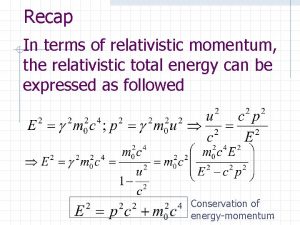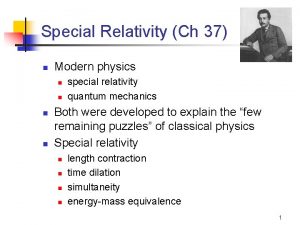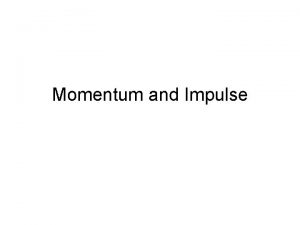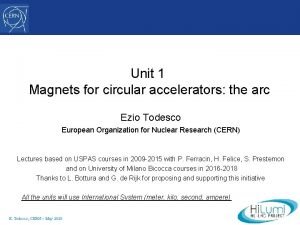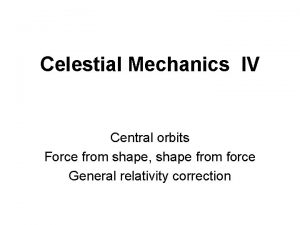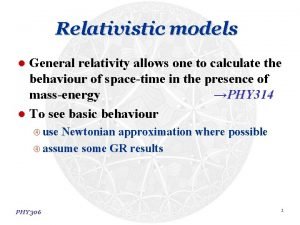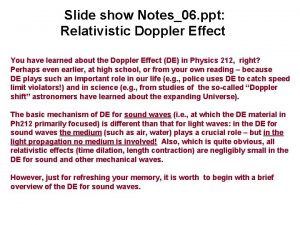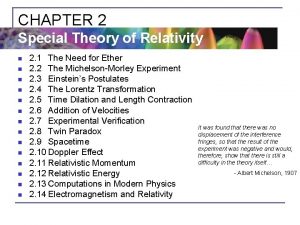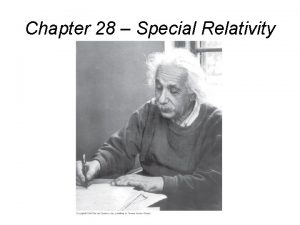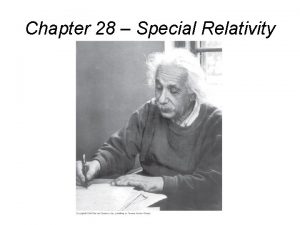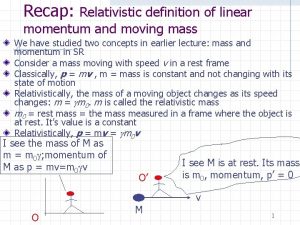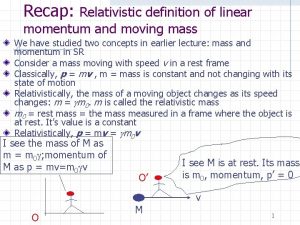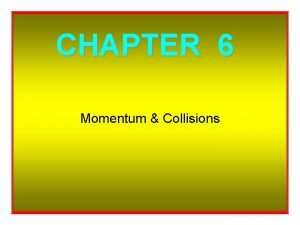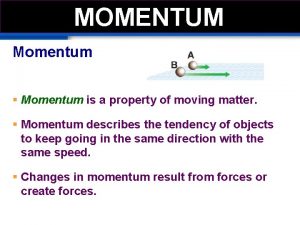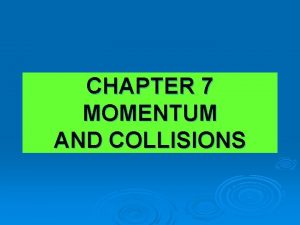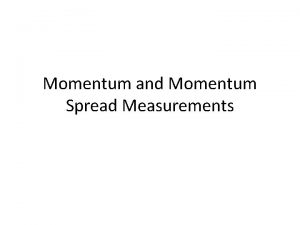Recap In terms of relativistic momentum the relativistic














- Slides: 14

Recap In terms of relativistic momentum, the relativistic total energy can be expressed as followed Conservation of energy-momentum 1

Reduction of relativistic kinetic energy in the classical limit The expression of the relativistic kinetic energy must reduce to that of classical one in the limit u –> 0 when compared with c, i. e. 2

Expand g with binomial expansion For u << c, we can always expand g in terms of (u/c)2 as i. e. , the relativistic kinetic energy reduces to classical expression in the u << c limit 3

Example An electron moves with speed u = 0. 85 c. Find its total energy and kinetic energy in e. V. CERN’s picture: the circular accelerator accelerates electron almost the speed of light 4

Due to mass-energy equivalence, sometimes we express the mass of an object in unit of energy Electron has rest mass m 0 = 9. 1 x 10 -31 kg The rest mass of the electron can be expressed as energy equivalent, via m 0 c 2 = 9. 1 x 10 -31 kg x (3 x 108 m/s)2 = 8. 19 x 10 -14 J = 8. 19 x 10 -14 x (1. 6 x 10 -19)-1 e. V = 511. 88 x 103 e. V = 0. 511 Me. V 5

Solution First, find the Lorentz factor, g = 1. 89 The rest mass of electron, m 0 c 2, is 0. 5 Me. V Hence the total energy is E = mc 2 = g (m 0 c 2)= 1. 89 x 0. 5 Me. V = 0. 97 Me. V Kinetic energy is the difference between the total relativistic energy and the rest mass, K = E - m 0 c 2 = (0. 97 – 0. 51)Me. V = 0. 46 Me. V 6

Mass-energy equivalence: potential energy In some special case, a system has no potential energy nor kinetic energy, e. g. two nucleons at rest and separated far apart According to mass-energy equivalence E = mc 2 = K + E 0 However, in general, U and K for a system are not zero, e. g. two nucleons fused into one nucleus – potential energy will come into the play in such a nucleus and cannot be ignored In fact, not only does kinetic energy contribute to the relativistic mass, m, to the system, but potential energy too Hence, more generally, E = mc 2 = K + U + E 0 Hence, generally the mass of a system, m, would have a contribution not only from its kinetic energy but also from potential energy Its relativistic mass m and the rest mass m 0 will be different by an amount Dmc 2 = (m - m 0)c 2 = K + U (in previous lecture we have temporarily ignore the role of potential energy 7 for the sake of simplicity)

Example: a compressed spring Consider an uncompressed spring system with rest mass m 0 (We shall ignore the kinetic energy as we consider only rest spring) Uncompressed, Rest mass = m 0, total relativistic energy E = E 0 =m 0 c 2 (rest energy only) Now, the spring is compressed by Dx by some external force Compression caused by external force, Fext The work done by the external force will be converted into the potential energy of the spring, according to conservation of mechanical energy, Fext Dx = U. U will add to the total relativistic energy of the spring system: E = m 0 c 2 --–> E = m 0 c 2 + U 8

As the total energy, E, increases due to external U, the relativistic mass of the spring will increase by some small amount Dm due to mass-energy equivalence the increase in the mass is simply Dmc 2 = U E. g. if the spring constant k = 100 N/m, and is compressed by 10 cm, potential energy stored = U = kx 2/2 = 0. 5 J This will contribute to the total relativistic mass of the spring by a amount Dm = U/c 2 = 5. 56 x 10 -18 kg – what a tiny amount 9

Binding energy The nucleus of a deuterium comprises of one neutron and one proton. Both nucleons are bounded within the deuterium nucleus Neutron, mn proton, mp Nuclear fusion Initially, the total Energy = (mn+ mn)c 2 U After fusion, the total energy = mdc 2 + U Deuterium, md Analogous to exothermic process in 10 chemistry

U is the energy that will be released when a proton and a neutron is fused in a nuclear reaction. The same amount of energy is required if we want to separate the proton from the neutron in a deuterium nucleus U is called the binding energy 11

U can be explained in terms energy-mass equivalence relation, as followed For the following argument, we will ignore KE for simplicity sake Experimentally, we finds that mn + mp > md By conservation of energy-momentum, E(before) = E(after) m nc 2 + m pc 2 + 0 = m dc 2 + U Hence, U = (mp + mn)c 2 - mdc 2 = Dmc 2 The difference in mass between deuterium and the sum of (mn + mn)c 2 is converted into the binding energy that binds the proton to the neutron together (opposite to the case of a compressed spring – in deuterium its mass decreases) 12

Example mn= 1. 008665 u; mp= 1. 007276 u; md= 2. 013553 u; u = standard atomic unit = mass of 1/12 of the mass of a 12 C nucleus = 1. 66 x 10 -27 kg = 1. 66 x 10 -27 x c 2 J = 1. 494 x 10 -10/(1. 6 x 10 -19) e. V = 933. 75 x 106 e. V = 933. 75 x Me. V • Hence the binding energy U = Dmc 2 = (mp + mn)c 2 - mdc 2 =0. 002388 u = 2. 23 Me. V 13

SR finishes here… We will go to the next topic … Mainly on the quantum picture of light and matter 14
 Relativistic momentum
Relativistic momentum Relativistic momentum
Relativistic momentum Conceptual physics chapter 6 momentum
Conceptual physics chapter 6 momentum Change in momentum formula
Change in momentum formula Polynomial classification
Polynomial classification Like terms
Like terms Cognitive development in early adulthood
Cognitive development in early adulthood Relativistic circular motion
Relativistic circular motion Clairaut equation
Clairaut equation General relativity equation
General relativity equation Relativistic doppler effect ppt
Relativistic doppler effect ppt Relativistic velocity
Relativistic velocity Relativistic kinetic energy
Relativistic kinetic energy Relativistic thinking example
Relativistic thinking example A physical education chapter 28
A physical education chapter 28
